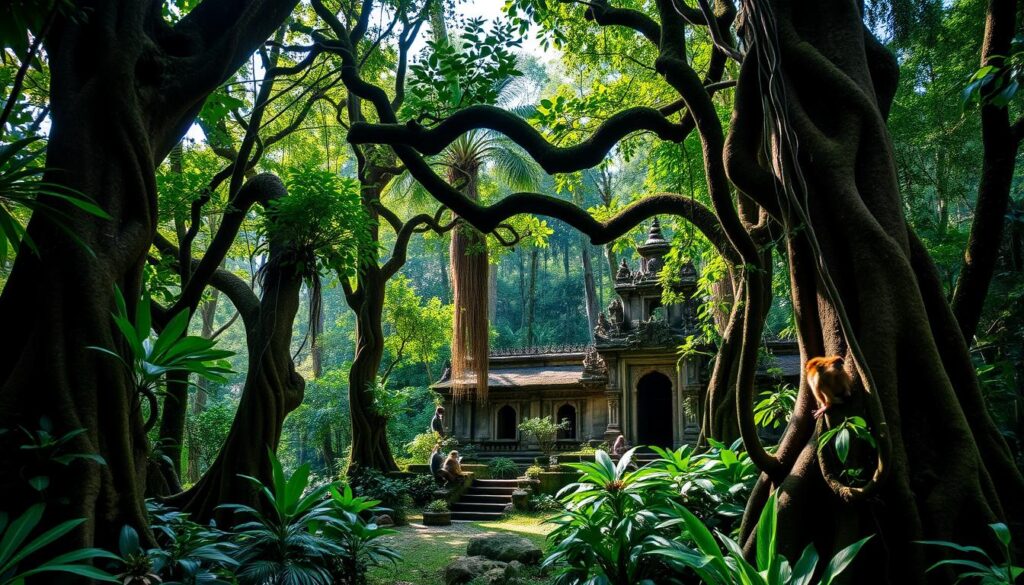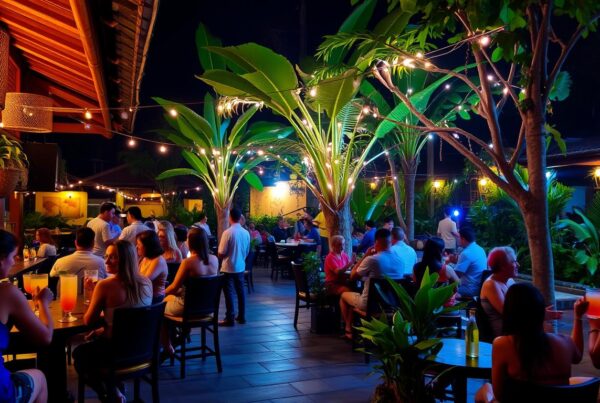G’day, mate! Ubud is the heart of Balinese culture. This charming town is packed with activities showcasing Indigenous arts and heritage. You’ll find traditional performances and hands-on craft workshops to suit any taste.
Picture yourself exploring ancient temples and watching graceful dancers tell stories. Try your hand at cooking local delicacies. Ubud’s lush surroundings, like rice terraces and monkey forests, create a magical atmosphere.
The Ubud Monkey Forest is home to over 700 cheeky long-tailed macaques. It’s a ripper of a time! Fancy a bit of adventure? Give cave tubing a go.
It’s great for solo travellers or small groups. Want a bird’s-eye view? The Ubud swing at Alas Harum offers three fantastic options. There’s even a romantic bed swing for couples.
Key Takeaways
- Ubud is the cultural heart of Bali, offering diverse Indigenous arts experiences
- The town boasts ancient temples, traditional dance performances, and cooking classes
- Ubud Monkey Forest is home to over 700 long-tailed macaques
- Adventure activities like cave tubing and Ubud swings are available
- The surrounding landscape includes iconic rice terraces and lush forests
Exploring Ubud’s Rich Cultural Heritage
Ubud is a beacon of Balinese culture, drawing visitors with its vibrant art and tradition. This town in Bali’s heartland offers unique cultural experiences that captivate tourists year-round.
The Heart of Balinese Arts and Crafts
Ubud’s streets showcase the best of Balinese craftsmanship. Artisan shops display intricate wood carvings, vivid paintings, and delicate textiles. These crafts reflect centuries of artistic evolution, telling stories of Balinese heritage.
- Wood carving workshops
- Batik making classes
- Silver jewellery crafting
A Brief History of Ubud’s Cultural Significance
Ubud’s cultural roots intertwine deeply with Balinese Hinduism. The town’s history is visible in its numerous temples and daily religious offerings.
Over time, Ubud has drawn artists from across the globe. This influx has cemented its status as Bali’s cultural capital.
| Period | Cultural Significance |
|---|---|
| Pre-20th Century | Traditional arts centre |
| Early 20th Century | Influence of foreign artists |
| Present Day | Global cultural hub |
Ubud hosts world-renowned events like the Bali Arts Festival in June. The Ubud Writers & Readers Festival in October is another highlight.
These gatherings celebrate Ubud’s rich cultural heritage. They attract visitors globally, making Ubud a must-visit spot for culture lovers.
Traditional Balinese Dance Performances
Ubud’s cultural scene shines through its traditional dance performances. These shows reveal Bali’s rich heritage with intricate costumes and expressive movements. Ancient stories come to life in these captivating displays.
Ramayana Ballet at Ubud Palace
The Ramayana Ballet at Ubud Palace is a must-see cultural event. This Hindu tale unfolds through graceful dancers, ornate costumes, and mesmerising music. Performances start at sunset, creating magic in the palace’s open-air theatre.
Legong and Barong Dances
Legong and Barong dances are iconic Balinese theatre forms. Legong, performed by young girls, features sophisticated movements and elaborate headdresses. The Barong dance shows male performers in trance-like states, portraying good versus evil.
Where to Watch Authentic Performances
Ubud offers many venues for authentic cultural shows. Ubud Palace hosts nightly performances, while Saraswati Temple provides a stunning backdrop. Many stages throughout town showcase these art forms.
| Dance Type | Key Features | Typical Performers |
|---|---|---|
| Pendet | Opening ceremony dance | Women |
| Barong | Trance-like state, ceremonial knives | Men |
| Legong | Sophisticated movements | Pre-pubescent girls |
| Kecak | Chanting to emulate gamelan | Group of men |
UNESCO recognises these dances as Intangible Cultural Heritage. They offer a unique glimpse into Balinese culture. From sacred temple rituals to tourist shows, Ubud’s dance scene caters to all interests.
Visiting Sacred Temples and Spiritual Sites
Ubud’s spiritual landscape features many Hindu temples and sacred sites. These places are central to religious ceremonies and spiritual practices. Both locals and visitors are drawn to their beauty and significance.
The Saraswati Temple honors the Hindu goddess of knowledge and arts. Its stunning architecture and serene lotus pond captivate visitors. People can admire intricate carvings and join peaceful meditation sessions here.
Tirta Empul Temple is an ancient water temple with purification pools. These pools are fed by natural springs. Tourists can take part in traditional cleansing rituals, experiencing Balinese spiritual practices firsthand.
“Bali’s temples are not just places of worship, but living museums of art and culture,” says local guide Wayan Suarta.
The Monkey Forest sanctuary houses two notable temples: Pura Dalem Agung Padangtegal and Pura Beji. These sacred spaces blend nature and spirituality beautifully. Visitors can observe religious ceremonies in lush, green surroundings.
| Temple | Key Feature | Spiritual Significance |
|---|---|---|
| Saraswati Temple | Lotus pond | Knowledge and arts |
| Tirta Empul | Purification pools | Cleansing rituals |
| Pura Dalem Agung | Ancient architecture | Death and afterlife |
| Pura Beji | Natural surroundings | Harmony with nature |
Ubud’s temples offer a deep dive into Balinese spirituality. Visitors can witness age-old traditions and join in meaningful rituals. These sacred spaces showcase the island’s rich cultural heritage in a living, breathing way.
Immersing in Local Art at Ubud’s Museums
Ubud’s art scene bursts with traditional and contemporary works. The town’s museums showcase Bali’s rich cultural heritage. Visitors can explore Balinese paintings and attend cultural exhibitions.
Agung Rai Museum of Art (ARMA)
ARMA boasts an impressive collection of Balinese, Indonesian, and international artworks. Its exhibits span various periods and styles, showing Balinese art’s evolution. Visitors can admire intricate wood carvings, colourful paintings, and traditional textiles.
Blanco Renaissance Museum
This museum was once home to the flamboyant artist Antonio Blanco. It displays his eclectic works and offers a unique glimpse into his life. The museum’s striking architecture and lush gardens add to its charm.
Neka Art Museum
Neka Art Museum takes you on a journey through Balinese art history. Its extensive collection showcases the diversity of Balinese artistic expression. Art lovers can explore themed pavilions featuring works by local and international artists.
| Museum | Specialty | Notable Features |
|---|---|---|
| ARMA | Diverse art collection | Traditional and contemporary works |
| Blanco Renaissance | Antonio Blanco’s artworks | Artist’s former residence and gardens |
| Neka Art Museum | Balinese art history | Themed pavilions and chronological displays |
Ubud’s art museums offer a deep dive into Balinese art. Visitors can see how artistic styles have changed over time. These museums open doors to understanding Bali’s rich artistic heritage.
Participating in Traditional Cooking Classes
Ubud’s traditional cooking classes offer a tasty peek into Balinese culture. These hands-on experiences have become popular among travellers. They’re now a key part of Ubud’s growing culinary tourism scene.
In these classes, you’ll explore Balinese cuisine up close. You might start with a trip to local markets to learn about native ingredients. Then, expert chefs will guide you in making famous dishes like satay lilit.
These workshops are more than just cooking lessons. They celebrate Balinese heritage and boost cultural understanding. As you prepare each dish, you’ll learn its history and traditions.
| Benefits of Cooking Classes | Impact on Ubud |
|---|---|
| Cultural immersion | Economic growth |
| New culinary skills | Support for local producers |
| Social connections | Preservation of culinary heritage |
These culinary experiences greatly help Ubud’s economy. They support local markets, restaurants, and food artisans. This creates a tourism model that benefits the whole community.
Joining a cooking class is more than just learning about food. It’s a sensory journey that feeds your body and soul. You’ll create lasting memories of your time in Ubud.
Cultural Activities in Ubud’s Iconic Monkey Forest
Ubud’s Monkey Forest is a living embodiment of Balinese philosophy and culture. It’s open daily from 9 a.m. to 4 p.m. The entrance fee is 80,000 IDR, offering a chance to explore Bali’s rich heritage.

Understanding the Tri Hita Karana Philosophy
The Monkey Forest follows the ancient Tri Hita Karana philosophy. This Balinese concept emphasises harmony between humans, nature, and the divine. The forest showcases this balance among its inhabitants, spiritual sites, and visitors.
Exploring Ancient Temples Within the Forest
Ancient temples in the sanctuary offer insights into Balinese Hindu traditions. The Pura Dalem Agung Padangtegal temple highlights the area’s spiritual importance. These sacred structures create a unique backdrop for cultural exploration.
Visitors can observe hundreds of long-tailed macaques in their natural habitat. This provides a firsthand look at wildlife living alongside spiritual landmarks. The Monkey Forest offers a deeper understanding of Bali’s cultural tapestry.
Experiencing Balinese Healing and Wellness Practices
Ubud shines as a spiritual wellness hub. It offers holistic therapies rooted in ancient Balinese traditions. Visitors can enjoy practices that nourish their mind, body, and soul.
Traditional healers, called Balians, are vital to Ubud’s wellness scene. They provide spiritual guidance and time-honored treatments. Many spas blend their wisdom into modern therapies.
Balinese wellness harnesses nature’s healing power. Local herbs, flowers, and oils are common in treatments. Yoga and meditation often happen in lush gardens or rice field terraces.
“Tri Hita Karana, our philosophy of harmony with God, people, and nature, forms the foundation of Balinese healing,” explains a local practitioner.
Ubud’s temples offer deep spiritual experiences. The Tirta Empul Temple hosts the Melukat ceremony. This cleansing ritual uses sacred spring water to restore balance.
| Wellness Practice | Description | Benefits |
|---|---|---|
| Balinese Massage | Traditional techniques using aromatherapy oils | Relaxation, improved circulation |
| Herbal Body Wraps | Application of local herbs and spices | Detoxification, skin nourishment |
| Meditation | Guided sessions in natural settings | Stress reduction, mental clarity |
Ubud’s wellness approach helps visitors reconnect with themselves and nature. Traditional healers, spiritual rituals, and natural therapies offer rejuvenating experiences. The journey promises both physical and spiritual enlightenment.
Exploring the Tegalalang Rice Terraces
The Tegalalang Rice Terraces showcase Bali’s farming legacy. These UNESCO-recognised landscapes feature the Subak irrigation system. This ancient method highlights sustainable farming that’s shaped Bali’s culture for centuries.

Learning About Traditional Farming Techniques
Tegalalang offers rich farming experiences for visitors. The terraces are most picturesque just before harvest in March/April or September/October. During these times, lush green fields provide stunning photo opportunities.
Early morning visits, especially at sunrise, offer the best light and fewer crowds. Arrive early to catch the iconic light rays. Wear sturdy shoes as there are several kilometres of trails to explore.
Participating in Rice Planting Activities
Visitors can join rice planting or harvesting, depending on the season. These hands-on experiences reveal age-old farming practices. They show how Balinese communities have thrived for generations.
Entrance fees range from 15,000 to 20,000 IDR per person. Extra costs apply for parking and activities like swing rides. Farmers may ask for 10,000 to 20,000 IDR donations for terrace access.
Respect this UNESCO World Heritage Site and local landowners during your visit. Engaging in these activities deepens appreciation for Bali’s farming heritage. It also highlights sustainable practices that continue shaping the island’s landscape.
Attending Local Festivals and Ceremonies
Ubud’s calendar is packed with Balinese festivals and religious celebrations. These events offer a deep dive into vibrant cultural experiences. In 2020, Ubud hosted 14 cultural festivals, a 20% increase from the previous year.
Each event drew an average of 4,500 attendees. This shows growing interest in Ubud’s rich cultural tapestry. Local artisan participation grew by 15%, highlighting increased community engagement.
The Ubud Writers & Readers Festival is a literary gem. It attracts wordsmiths and bookworms from around the world. Religious celebrations like Galungan and Nyepi showcase Balinese Hindu traditions.
Colourful processions, traditional music, and elaborate offerings fill streets and temples. Visitors can witness authentic ceremonies at many Ubud temples. Each offers unique insights into Balinese culture.
“Attending cultural events in Ubud broadens one’s perspective on life and contributes to overall well-being,” shares a frequent festival-goer.
These festivals have a significant economic impact. Local businesses reported a 30% revenue increase during event periods. This underlines the importance of these celebrations to the community.
| Festival Statistic | Value |
|---|---|
| Number of Cultural Festivals (2020) | 14 |
| Increase in Festivals from Previous Year | 20% |
| Average Attendance per Festival | 4,500 |
| Participant Satisfaction Rate | 95% |
| Local Business Revenue Increase | 30% |
Learning Traditional Balinese Crafts
Ubud brims with Balinese art and culture. Visitors can join artisan workshops to explore traditional crafts. These hands-on sessions offer insight into Balinese artistry and cultural heritage.
Wood Carving Workshops
Wood carving is central to Balinese art. Ubud hosts 60-minute workshops on Tuesdays and Fridays. You’ll learn to create intricate sculptures and ornaments, crafting your own Bali souvenir.
Batik Making Classes
Batik, a wax-resist dyeing technique, is key to Indonesian textiles. Ubud’s batik painting classes let you design your own fabric. These 90-minute workshops cost US$85 for adults and US$55 for kids under 12.
Silver Jewellery Crafting
Design and create your own silver jewellery using traditional methods in Ubud. These classes showcase the skill of Balinese silversmiths. You’ll leave wearing your own handcrafted piece.
| Craft Workshop | Duration | Price (USD) | Availability |
|---|---|---|---|
| Wood Carving | 60 minutes | 30 | Tuesday, Friday |
| Batik Making | 90 minutes | 85 (Adult), 55 (Child) | Daily |
| Silver Jewellery | 120 minutes | 100 | Monday, Thursday |
Ubud’s artisan workshops teach more than just crafts. They help create cultural ambassadors who value diverse customs. With 25 years of experience, these centres offer a unique look into Bali’s artistic heritage.
Conclusion
Ubud is a hub of Balinese culture. It offers authentic experiences that showcase local traditions. From dance shows at Ubud Palace to the beauty of Tegalalang Rice Terraces, visitors can enjoy many activities.
The town’s art scene shines in museums like ARMA and Neka. These places give insights into Balinese art. Cooking classes and craft workshops let travellers engage with local customs.
Ubud’s temples and Monkey Forest offer spiritual encounters. Ancient wellness practices provide a holistic cultural experience. These activities help preserve Bali’s unique identity.
Take the spirit of Ubud with you when you leave. Let your experiences spark curiosity about different traditions. Appreciate the value of cultural exchange in our connected world.



